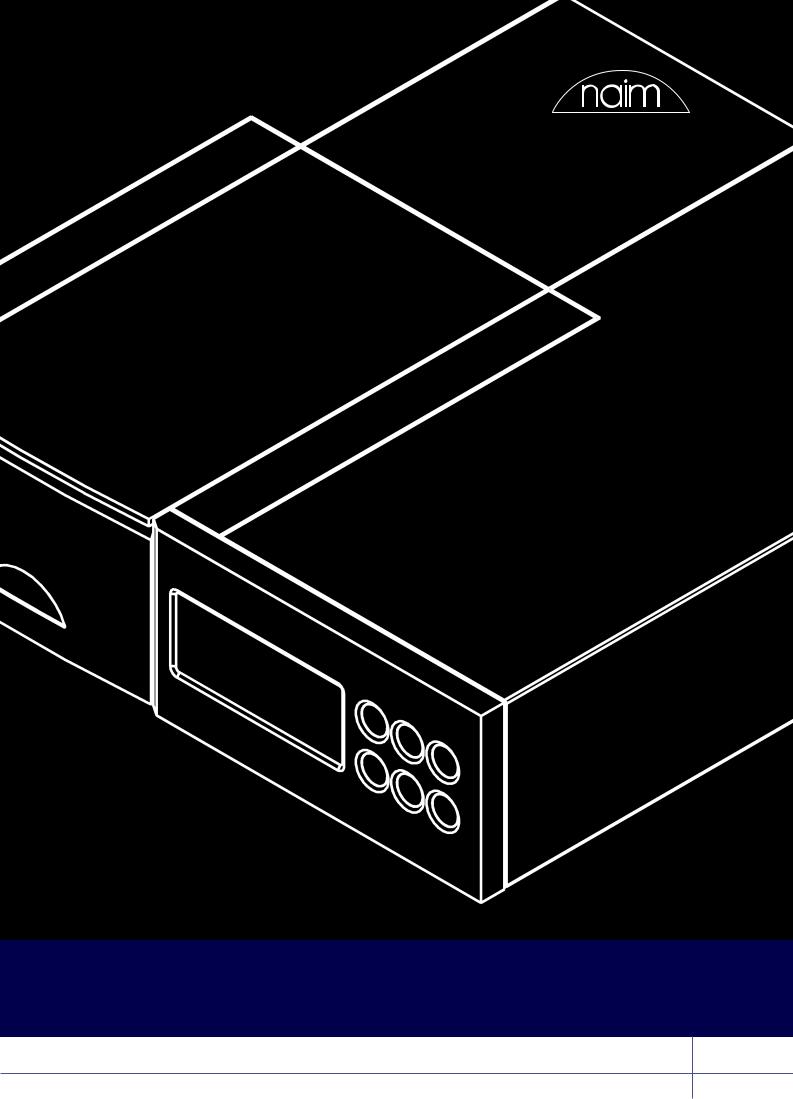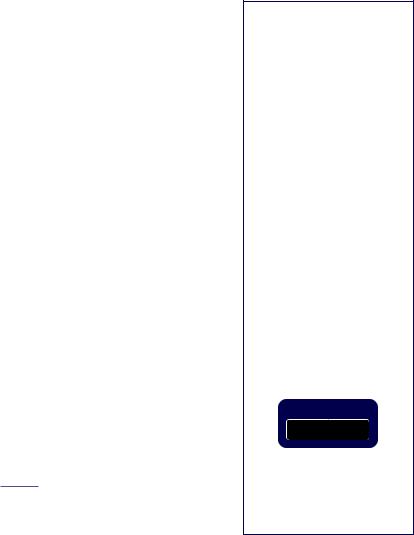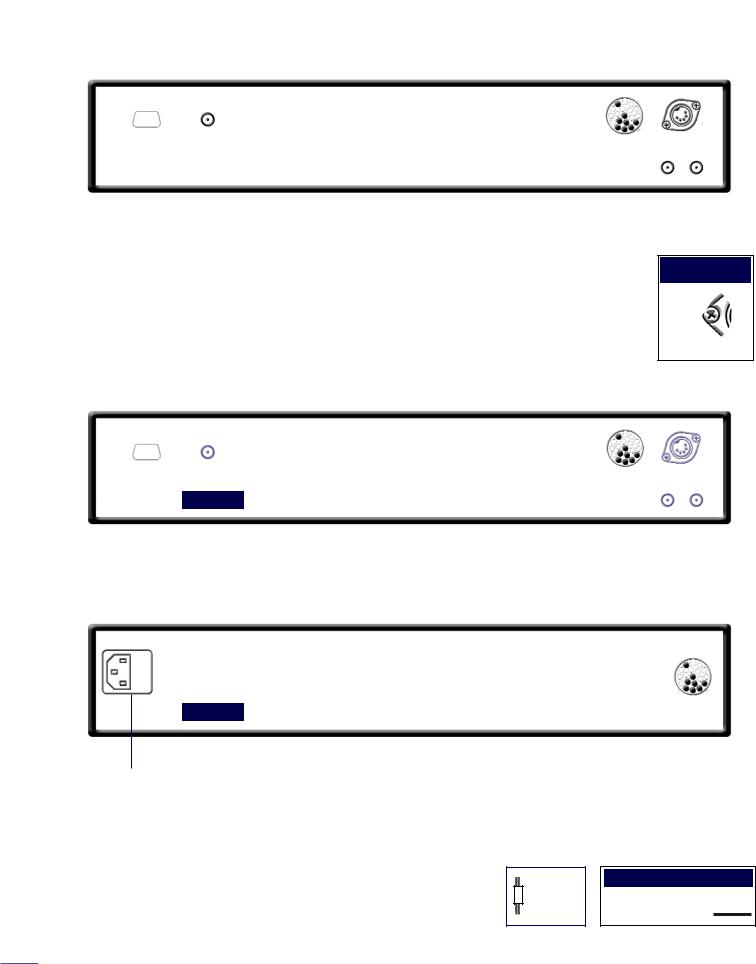Naim Audio CDS-3 Owners manual

W O R L D C L A S S H I F I
O W N E R S M A N U A L I S S U E 2
CD Players: CDS3, CDX2, CD5

Introduction |
|
|
|
|
Naim Audio products are always conceived with performance as the |
CONTENTS |
|||
Page |
Section |
|||
|
|
|||
top priority and careful installation will help ensure that their full |
1 |
1 Equipment Installation |
||
potential is achieved. This manual begins with statutory safety |
1 |
2 Cables and Connections |
||
1 |
3 Getting Started |
|||
warnings and general installation tips for all Naim Audio products. |
||||
|
3.1 switching on and off |
|||
Product specific information begins in Section 6. |
|
3.2 running in |
||
2 |
3.3 mains supply |
|||
|
|
|||
|
|
|
3.4 siting the equipment |
|
|
|
|
3.5 if you have a problem |
|
1 Equipment Installation |
|
2 |
4 Warnings |
|
|
3 |
5 Connection |
||
Normally your Naim equipment will have been installed by the dealer who sold it to you |
||||
|
5.1 mains lead |
|||
even if you live outside their immediate vicinity. Your dealer is responsible for making |
|
|||
|
5.2 mains plugs |
|||
sure that the system sounds exactly as it should and information given here is not |
|
|||
|
5.3 fuse carrier |
|||
intended to reduce this responsibility in any way. |
|
|
5.4 plug fuses |
|
|
|
4 6 CDS3 Installation and |
||
2 Cables and Connections |
|
|
Operation |
|
|
6 7 CDS3 Rear Panel and |
|||
Please do not modify the standard interconnect cables |
|
|
Connection Diagrams |
|
supplied with your Naim equipment. This is important for |
|
7 |
8 CDS3 Operation |
|
safety as well as performance. One end of each cable is |
|
|
Diagrams |
|
marked with a band to establish its correct orientation. |
|
9 9 CDX2 Installation and |
||
The band always marks the end that connects to the |
|
|
Operation |
|
signal source. |
|
11 10 CDX2 Rear Panel and |
||
Loudspeaker leads are also very important. Naim |
|
|
Connection Diagrams |
|
|
12 11 CD5 Installation and |
|||
loudspeaker cable is correct for your system and your |
|
|||
|
|
Operation |
||
dealer will make up leads to suit your equipment |
|
13 12 CD5 Rear Panel and |
||
installation. The leads should each be at least 3.5 metres |
|
|||
|
|
Connection Diagrams |
||
long and of equal length. The recommended maximum is |
|
14 13 CDX2/CD5 Operation |
||
20 metres. Loudspeaker leads are, like interconnect leads, |
|
|
Diagrams |
|
directional, and should be connected so that the printed |
|
16 |
14 Puck Identification. |
|
arrow points towards the speakers. Using alternative |
|
17 |
15 Flash Handset |
|
loudspeaker cable will degrade performance, and may even |
|
19 |
16 Narcom 3 Handset |
|
damage your amplifier. An exception to these loudspeaker |
3 Getting Started |
21 |
Standards Declaration |
|
cable constraints is the NAP 6-50 multi-room power |
|
|
||
|
|
|
||
|
|
|
||
amplifier. The NAP 6-50 is designed to be tolerant of both |
3.1 switching on and off |
|
|
|
a wide variety of cable types, and cable runs well in excess |
|
|
||
Source components and power supplies for cd players, |
||||
of 20m. The loudspeaker connectors supplied with all Naim |
||||
tuners, preamplifiers and crossovers should be switched |
||||
amplifiers and loudspeakers have been specifically |
||||
on before switching on the power amplifier(s). Always |
||||
designed to make a robust mechanical connection. It is |
||||
switch the amplifier(s) off and wait about a minute for |
||||
essential that these are used in order to comply with |
||||
the power supply capacitors to discharge before |
||||
current European safety regulations. |
||||
connecting or disconnecting any leads. Always use the |
||||
|
||||
All the plugs and sockets supplied with your Naim |
power switch on the product rather than a mains outlet |
|||
equipment have been chosen because they make the best |
switch. |
|
|
|
possible connection for their purpose. A poor contact will |
|
|
|
|
degrade the signal substantially and plugs and sockets |
3.2 running in |
|
|
|
should look clean and free from corrosion. The easiest way |
Your Naim equipment will take a considerable time to run |
|||
to clean them is to switch off the equipment, pull the plugs |
in before it performs at its best. The duration varies, but |
|||
out of their sockets, and push them back in again. Special |
under some conditions you will find that the sound |
|||
contact cleaners and contact enhancers should not be |
continues to improve for as much as five weeks. Better and |
|||
used as they tend to deposit a film which is very difficult to |
more consistent performance will be achieved if the system |
|||
remove and may degrade the sound. |
is left switched on for long periods. It is worth |
|||
|
remembering however that all electronic equipment can be |
|||
|
damaged by lightning. Please read the warnings section. |
|||
1

Introduction
3.3 mains supply
Where fused plugs are used 13 amp fuses should be fitted. Fuses of a lower rating will fail after a period of use.
A hi-fi system usually shares a mains circuit with other household equipment some of which can cause distortion of the mains waveform. In some Naim equipment such distortion can lead to a mechanical hum from the transformers. The hum is not transmitted through the speakers and has no effect on the performance of the system but is purely local to the transformer itself. A separate fused mains circuit (like that reserved for electric cookers) may reduce transformer hum. Such a circuit (ideally with a 30 or 45 Amp rating) will also have a lower impedance, supply cleaner power, and consequently improve system performance.
Do not wire voltage dependent resistors or noise suppressors into mains plugs. They degrade the mains supply and the sound.
IMPORTANT
In order to comply with current European safety regulations it is essential that the Naim loudspeaker connectors supplied with amplifiers and loudspeakers are used.
Do not under any circumstances allow anyone to modify your Naim equipment without first checking with the factory, your dealer, or your distributor. Unauthorised modifications will invalidate your guarantee.
For your own safety do not under any circumstances open Naim equipment without first disconnecting the mains.
The following label is attached to all mains powered equipment:
W A R N I N G
THIS APPARATUS
MUST BE EARTHED
2
3.4 siting the equipment
Power supplies and amplifiers should be located a reasonable distance away from other equipment. This separation will stop transformer radiation causing hum audible from the loudspeakers. The maximum separation distance for connected equipment is that allowed by the standard interconnect lead.
Some Naim equipment is extremely heavy. Ensure that your equipment rack or table can easily support the weight and is stable.
3.5 if you have a problem
Legal consumer protection varies from country to country. In most territories a dealer must be prepared to take back any Naim equipment he has sold you if he cannot make it work to your satisfaction in your own home. A problem may be due to a fault in any part of the system or its installation so it is essential to make full use of your local dealer’s diagnostic skills on site. Please contact your local distributor, or Naim at the address in the back of this manual, if any difficulties cannot be resolved. Some Naim equipment is made in special versions for different territories and this makes it impracticable to arrange international guarantees. Please establish the guarantee arrangements with your own dealer at the time of sale. We are always available to offer help and advice.
It is essential that repairs and updates are only carried out by an authorised Naim dealer, or at the factory by Naim itself. Many components are made, tested or matched specially for Naim and appropriate replacements are often unobtainable from non-specialist sources.
4 Warnings
Naim equipment is designed to offer the finest sound quality that can be achieved avoiding compromise wherever possible. This can lead to circumstances that may be unfamiliar. The material that follows contains advice specifically related to Naim equipment as well as more general warnings about the use of domestic audio products. Please read it carefully.
The transformers in Naim power amplifiers and power supplies may sometimes make a mechanical noise caused by distortion of the mains waveform. Naim transformers are large in size and have heavy gauge secondary windings making them relatively sensitive to such distortion. A separate mains circuit for your hi-fi system may reduce the effect while also giving an overall improvement in sound quality. It may be necessary however to take account of mechanical transformer noise when siting your equipment.

Introduction
In some circumstances, depending on where you live and the earthing arrangements in your home, you may experience radio frequency interference. Controls on broadcasting in some territories allow very high levels of radio frequency radiation and both the choice and exact siting of equipment may be critical. If there is a known problem in your locality it is advisable to arrange for a home demonstration before purchase to find out if Naim equipment is likely to be affected. Susceptibility to radio frequency interference is related to the wide internal bandwidth necessary for high sound quality. Systems incorporating moving coil phono preamplifiers and active crossovers are more likely to suffer. A radio frequency filter kit is available for some Naim equipment but sound quality will be progressively compromised as more elements of the kit are fitted. In situations of extreme radio interference Naim equipment may be unsuitable.
Your Naim hi-fi system can be damaged by lightning. Power amplifiers are particularly at risk and should be turned off when there is risk of lightning strike. For complete protection all mains plugs and any aerial cables should be disconnected when not in use.
Equipment must not be exposed to dripping or splashing and no objects filled with liquid, such as vases, should be placed on the equipment.
Use of non-standard speaker cables or interconnects may invalidate your guarantee.
5 Connection
5.1 mains lead
As the colours of the wires in the mains lead of this apparatus may not correspond with the coloured markings identifying the terminals in your plug proceed as follows:
The wire which is coloured GREEN-AND-YELLOW must be connected to the terminal in the plug which is marked by the letter E or by the safety earth symbol or coloured green or green-and-yellow.
The wire which is coloured BLUE must be connected to the terminal in the plug which is marked with the letter N or coloured black.
The wire which is coloured BROWN must be connected to the terminal in the plug which is marked with the letter L or coloured red.
5.2 non-rewireable mains plugs
If a non-rewireable plug is cut from a mains lead (for whatever purpose) the plug MUST be disposed of in a way to render it totally useless. Considerable shock hazard exists if the cut-off plug is inserted into a mains outlet.
5.3 fuse carrier
Should the plug fuse carrier be damaged or lost, the correct replacement must be obtained from your dealer, or from Naim Audio direct. Do not use the plug until the fuse carrier is replaced.
5.4 plug fuses
Replace only with ASTA or BS 1362 approved fuses.
NOTE
This equipment has been tested and found to comply with the relevant EMC and Safety Standards, and, where applicable, also complies with the limits for a class B digital device, pursuant to Part 15 of the FCC Rules.
These limits are designed to provide reasonable protection against harmful interference in a residential installation. This equipment generates, uses and can radiate radio frequency and, if not installed and used in accordance with the instructions, may cause harmful interference to radio communications. However, there is no guarantee that interference will not occur in a particular installation. If this equipment does cause harmful interference to radio or television reception, which can be determined by turning off and on, the user is encouraged to try to correct the interference by one or more of the following measures:
•Reorient or relocate the receiving antenna.
•Increase the separation between the equipment and the receiver.
•Connect the equipment into an outlet on a circuit different from that to which the receiver is connected.
•Consult your Naim dealer or an experienced radio/TV technician for help.
3

CDS3
6 Installation and Operation
The CDS3 CD Player can only be operated from a Naim XPS Power Supply. Connection of the power supply is illustrated in Diagram 7.2
The CDS3 should be installed on a dedicated equipment stand intended for the purpose. To improve sound quality the player has hard metallic feet which may blemish any delicate surface on which it is placed. Do not stand the player directly on top of another item of Naim Audio equipment. Care should be taken to ensure that the player is level.
Transit screws on the underside of the CDS3 case and beneath its transport lid should be removed before use and must be replaced if the unit is to be moved or re-packed and shipped. The transit screw locations are illustrated in Section 8.1. The transit screws must not be used in any other Naim product. Do not invert the player once the transit screws are removed.
6.1 disc loading
Disc loading is illustrated in Section 8.2. To load a compact disc lift the transport lid from the front of the player. Place the disc on the platter followed by the magnetic puck. Do not use a puck from any other Naim CD player. Different Naim CD players use dissimilar pucks. The illustration in Section 14 will help identify the correct puck for the CDS3.
If an HDCD® encoded compact disc is loaded the CDS3 will automatically recognise and decode it. The display will read HDCD for a few seconds after play is pressed.
6.2 player controls
previous: With a disc loaded but not playing the previous button searches the disc contents backwards, either one track at a time, or sequentially if the button is held. While a disc is in play, the previous button searches the table of contents backwards. Play resumes with the selected track when the button is released.
next: |
The next button operates in the same way as |
|
the previous button, but moving forwards |
|
through the disc instead of backwards. |
stop: |
Stops play and resets the player to its start |
|
condition. Pressing and holding stop will clear |
|
any programmed play order, or, if no play order |
|
is programmed, return the player display to its |
|
default state (track indication). |
play: |
Plays a disc from track one unless another track |
|
has been selected. Play operated while a track |
|
is playing will re-start the track. |
pause: |
Pauses play. Pressing pause a second time will |
|
resume replay. If play is selected while the |
|
player is paused, replay will resume at the start |
|
of the paused track when pause is deselected. |
|
The pause button indicator will flash when pause |
|
is selected. |
If the CDS3 is paused for more than 10 minutes it will enter a “static pause” mode in which the transport laser deactivates and the disc stops spinning - so reducing wear on the transport. The player can be left in static pause indefinitely. The pause button indicator will illuminate fully rather than flash when the player is in static pause mode.
Pressing the pause button will deselect static pause. Replay will resume at the pause point.
display: Scrolls through the display options of “track”, “time” and display off.
All CD control functions are duplicated on the NARCOM 3 and Flash remote handsets. The handsets also provide CD programming facilities. See Sections 15 and 16 for more information.
6.3 front panel control mode selection
The CDS3 has an optional front panel control mode. This multi-function mode provides an alternative front panel interface in which fast forward and fast reverse can be selected by pressing and holding next and previous respectively.
To select multi function mode press and hold next while the player switches on. To select the standard control mode press and hold previous while the player switches on.
4 |
®, HDCD®, High Definition Compatible Digital® and Pacific Microsonics™ are either registered trademarks or trademarks of Pacific Microsonics, Inc. in the United States and/or other countries. |

CDS3
6.4 player display and indicators
The alphanumeric display indicates track and index numbers, time in minutes and seconds, or various system messages (Error, Track programming info, etc). The full stop on the right of the display window illuminates when the player receives a signal from the remote handset. If a track play list is programmed the time displayed reflects the duration of the program. Above the display are four indicators.
HDCD: |
Illuminates to show that an HDCD encoded disc |
|
is playing. |
time: |
Illuminates to indicate display of total disc time |
|
or elapsed time of track being played. |
repeat: |
Illuminates to show that repeat has been |
|
selected from the remote handset. |
prog: |
Illuminates to indicate that a program has been |
|
stored. Further information on play list |
|
programming can be found in Sections 15 and 16 |
6.5 output socket selection
A pair of phono output sockets are fitted at the rear of the CDS3 to provide an alternative to the preferred DIN socket. Proceed as follows to select the phono sockets.
With the player stopped, press and hold the remote handset disp function (handset in CD mode) or front panel disp button until the CD player prog indicator flashes. Further operations of the disp function will now cycle through each combination of the two socket types (DIN only, phono only or both). The selected option is indicated on the CD player display as shown below.
Socket Option |
Player Display |
|
DIN |
O |
|
Phono |
O |
o 0 |
Both |
o 0 |
|
Press and hold the disp function a second time to exit from socket selection mode.
6.6 player maintenance
It is important for reliable operation of the CDS3 to ensure that the surfaces of the transport platter and the underside of the puck are free of dust or debris which can prevent the disc from sitting properly and cause it to slip.
To clean the transport platter, take a piece of Blu-tack and lightly apply it to the top surface of the magnetic metal hub, picking up any material attached to it. Brush the plastic outer edge lightly with your finger or a soft brush to ensure that it is dust and particle free. Similarly, clean the puck with Blu-tack, to remove debris from the three locating pins on its underside. Take care not to damage the rubber pressure pads. Brush them lightly with your finger or a soft cloth.
Do not, under any circumstances, use any solvents or fluids for the cleaning process.
5

CDS3
7.1 CDS3 Rear
|
|
|
|
|
|
|
|
|
|
XPS power supply connection socket |
|
|
|
|
|
|
|
|
|
|
|
|
|
|
|
|
|
|
|
|
|
|
|
|
|
|
|
|
|
|
|
|
|
|
|
|
|
|
|
|
|
|
|
|
|
|
|
|
|
|
|
|
|
|
|
|
|
|
|
|
|
|
|
|
|
|
|
|
|
|
|
|
|
|
|
|
|
|
|
|
|
|
|
|
|
|
|
|
|
|
|
|
|
|
|
|
|
|
|
|
|
|
|
|
|
|
|
|
|
|
|
|
|
|
|
|
|
|
alternative |
|
|
|
to preamplifier |
||||||
|
|
optional |
|
|
RC5 input |
|
|
|
|
||||||||||
|
|
|
|
|
|
||||||||||||||
|
|
RS232 |
|
|
|
|
|
RCA phono |
|
|
|
||||||||
|
|
|
|
|
|
|
|||||||||||||
|
|
data port |
|
|
|
|
|
output sockets |
|
|
|
||||||||
|
|
|
|
|
|
|
|
|
|
|
|
|
|
|
|
|
|
|
|
Note
The RC5 input fitted to the CDS3 is intended to accept external control signals for multi-room applications. Contact your dealer for further information on its use.
7.2 CDS3 Connected to XPS Power Supply
CDS3
XPS
mains input
cable direction marker
CDS3 Output
|
|
|
ch1 |
|
|
|
|
|
|
|
|||
|
|
|
out |
|
|
|
|
|
|
nc |
|||
|
|
|
ch 2 |
|
|
|
|
|
|
|
|
|
nc |
|
|
|
out |
|
|
-ve |
|||||||
|
|
|
|
|
|
|
|
|
|||||
|
|
|
|
|
|
|
|
||||||
|
|
|
|
|
|
|
|
|
|
|
|
|
|
|
|
|
|
|
|
|
|
|
|
|
|
|
|
|
|
|
|
|
|
|
|
|
|
|
|
|
|
|
|
|
|
|
|
|
|
|
|
|
|
|
|
|
|
|
|
|
|
|
|
|
|
|
|
|
|
|
|
|
|
|
|
|
|
|
|
|
|
|
|
Interconnect Cables
CDS3/XPS Burndy  180° 5 to 5 pin DIN
180° 5 to 5 pin DIN
6
